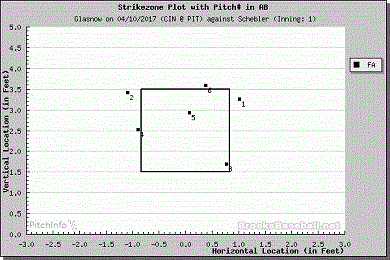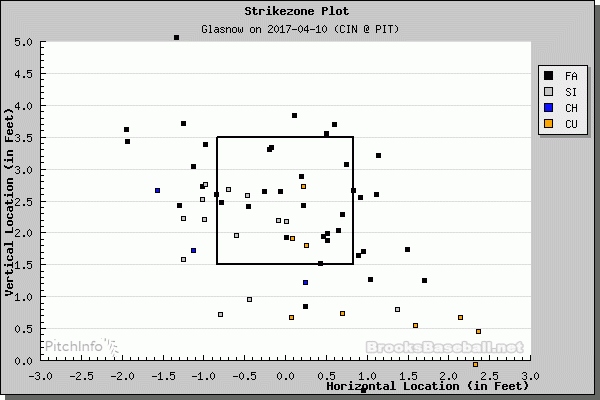This article is part of our Pitching 3D series.
Glasnow won the competition for the fifth starter's role in Pittsburgh, paving the way for his 2017 debut. Glasnow had been a hero of true outcomes in the minors, with a K-rate of 11.6 K/9 and a walk rate of 4.4 BB/9 in exactly 500 minor-league innings. The walk rate has long exemplified the right-hander's biggest issue, as his delivery lacked consistency and he has been unable to hit targets. However, a combination of electric stuff and incredible release-point extension have made him difficult to hit, resulting in a minor-league hit rate of just 5.3 H/9, supporting a microscopic 2.03 ERA.
| SEASON | IP | ERA | WHIP | K/9 | BB/9 | H/9 | HR/9 |
| MLB 2016 | 23.1 | 4.24 | 1.5 | 9.3 | 5.0 | 8.5 | 0.8 |
| MiLB '16 | 116.2 | 1.93 | 1.17 | 11.1 | 5.2 | 5.3 | 0.4 |
| ST 2017 | 17.1 | 6.23 |
Glasnow won the competition for the fifth starter's role in Pittsburgh, paving the way for his 2017 debut. Glasnow had been a hero of true outcomes in the minors, with a K-rate of 11.6 K/9 and a walk rate of 4.4 BB/9 in exactly 500 minor-league innings. The walk rate has long exemplified the right-hander's biggest issue, as his delivery lacked consistency and he has been unable to hit targets. However, a combination of electric stuff and incredible release-point extension have made him difficult to hit, resulting in a minor-league hit rate of just 5.3 H/9, supporting a microscopic 2.03 ERA.
| SEASON | IP | ERA | WHIP | K/9 | BB/9 | H/9 | HR/9 |
| MLB 2016 | 23.1 | 4.24 | 1.5 | 9.3 | 5.0 | 8.5 | 0.8 |
| MiLB '16 | 116.2 | 1.93 | 1.17 | 11.1 | 5.2 | 5.3 | 0.4 |
| ST 2017 | 17.1 | 6.23 | 1.85 | 14.5 | 3.6 | 13 | 1.0 |
Glasnow is a tall drink of water who's all legs, physical elements that contribute to an exceptional stride and a very deep release point. I consider deep release point extension to be a huge positive — it's part of what made Randy Johnson so devastating at his peak — but pitchers with extreme physical profiles like Glasnow are often targeted for their unorthodoxy, and he's no exception. The Pirates have been working with Glasnow to shorten his stride, theorizing that such an adjustment will help his walk rate, but it may have had the opposite effect, as messing with a pitcher's lower half typically has a ripple effect on timing, thus harming pitch command until the hurler masters the new timing pattern.
It always kills me when a pitcher has been successful with a long stride or strong momentum, and then that advantage is targeted as a negative by the organization that drafted him, essentially robbing the pitcher of his assets while lengthening his road of development. It's not too surprising, then, that Glasnow has had so many problems as he played slalom through the minors and tried to find a delivery that works.
Glasnow did some training this past offseason at Driveline (according to their Twitter feed), a pitching academy that emphasizes pitch velocity often at the expense of command. Unfortunately, velocity was already a strength of Glasnow's while his lack of pitch command was a clear weakness, making it likely that he was simply magnifying his existing strengths and weaknesses.
| IP | R | ER | H | HR | BB | K |
| 1.2 | 5 | 5 | 4 | 0 | 5 | 1 |
The apparent repercussions were evident in his first start of 2017, as Glasnow battled his own delivery through inconsistent timing and a volatile release point. He walked four batters in the first inning alone, walking in a pair of runs in the process. All of the walks came in a row and on 3-2 counts, so the command issues weren't quite as bad as implied by the box score, but a string of high-pitch at-bats resulted in a gruesome 45-pitch first inning that assured the right-hander of a short outing.
The second of the walked-in runs was to Scott Schebler, but one look at his pitch plot shows that Glasnow wasn't missing the zone by much.

Overall, Glasnow's timing was clearly off-kilter during the walk-fest, with several pitches that were over-rotated offset by under-rotated deliveries, as his momentum varied from too fast to too slow for his personal signature and the throwing arm struggled to line up with his gears of rotation. He threw 35 of 64 pitches for strikes and hit targets less often than that.

Out of 64 total pitches, Glasnow threw just nine curves and three changeups in this one according to Brooks exemplifying a day filled with fastball counts and an inability to hit targets. He also gave up four stolen bases in his less-than-two innings of work, twice being the victim of Billy Hamilton's Flying Circus (second base in the first inning, third base in the second as part of a double steal). The speed of Hamilton and the incessant foul balls by Cincinnati hitters formed the underlying glue for Glasnow's bad day, elements that won't necessarily be present on a start-to-start basis, but no pitcher wants to showcase his vulnerabilities in his first start of the year, particularly one who has so much to prove.
Glasnow's second start had a very different look than the first outing in terms of the peripheral stats, as he struck out seven batters with two walks, both of which came in his final frame. Unfortunately for Glasnow and the Pirates, the results were largely the same on the scoreboard, as the Cubs knocked the right-hander around for six runs in five innings of work.
| IP | R | ER | H | HR | BB | K |
| 5 | 6 | 4 | 6 | 1 | 2 | 7 |
The trouble started right off the bat, as the defending World Champions plated four runs in the first inning by collectively hitting for the cycle against Glasnow. Kyle Schwarber's leadoff double was a flare that tucked into fair territory and surprised everyone, including Schwarber himself, but the ensuring home run off the bat of Kris Bryant was a surprise to nobody.
Mechanically, Glasnow looked as if he had added some burst to his delivery in this start, increasing his momentum with an accelerated pace that exploded into foot strike. The charge of momentum was inconsistent, but on multiple occasions I saw him line up the gears for an incredibly effective delivery, utilizing his physical attributes to maximize his stride and track his release point closer to home plate.

The right-hander seriously upped the ante with his secondaries in his second game of the season. After throwing 52 fastballs in 64 pitches of his first start, Glasnow uncorked 26 changeups and 20 curveballs out of 99 pitches in his second start of the year. The Cubs teed off on the fastball, going 5-for-13 with a single, two double, a triple and a the Bryant home run all hit against Glasnow's heat.
The young pitcher started using his secondaries more liberally the second time through the batting order, and secondary pitches were responsible for finishing off all seven of his strikeouts and resulting in an 1-for-12 by Cubs' hitters. The effectiveness of both his changeup and his curveball were encouraging signs for Glasnow's ability to navigate through a lineup of major-league hitters that are stacked to exploit platoon advantages.
All Right, Now What?
Overall, there was progress in terms of pitch location as well as results, and the combination of his formidable opponent and functional improvements pave the way for optimism heading into Friday's start against the Yankees. There is light at the end of the tunnel, but it could be a long tunnel to navigate before Glasnow comes out cleanly on the other side. Riding out his learning curve is a path to disturbing ratios and the likelihood of single-game blowups, but Glasnow still owns the upside to make dents in a couple categories if he irons out the wrinkles in his delivery.
Whether to start depends somewhat on your league format and the shape of your pitching staff, but there are reasons to hope that it won't be a complete disaster if your team is in need of innings in the early season. I lean toward sit, as the kid needs time to settle into his delivery and to start him now is to take a big gamble that he won't get blown up again, but that's what fantasy benches are for and the upside is too great to release him back into the player pool in most formats.
The Pirates are going through a difficult stretch and their offense will be without Starling Marte (as well as Jung Ho Kang) for the foreseeable future, harming a Pittsburgh pitcher's run support as well as his defense. Expectations that Glasnow would suddenly figure it out at the highest level were misplaced, but he could be surprisingly effective in due time if fantasy managers have the patience to wait out his struggles.









